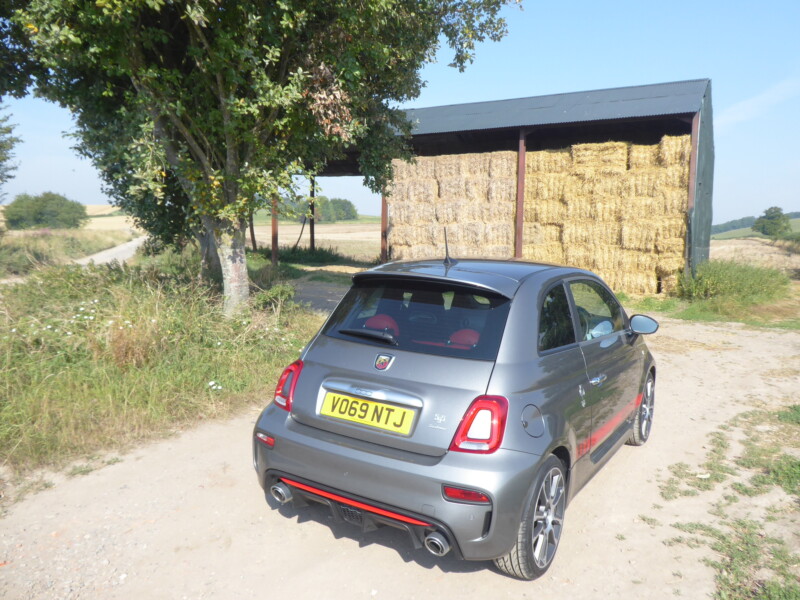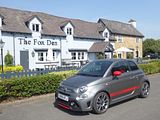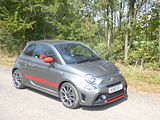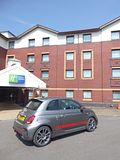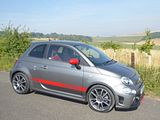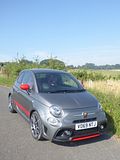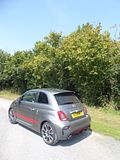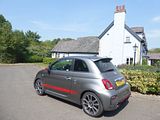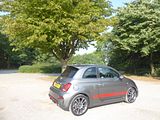I bought my first Abarth literally the day that I returned the car I had rented from Hertz for a long weekend birthday treat. That first car, and the one I replaced it with in September 2015, is a weekend “toy” and not my daily driver so typically covers around 4000 miles a year, which means that it needs a service based on time rather than mileage, and that means a once a year trip to an Abarth dealer. I’ve had all sorts of loan cars from the dealers I have used, but in 10 years, the only times I actually received an Abarth were this year and last. Whilst some owners would get upset about this, and are not slow in venting their disappointment all over social media, I have always been happy to try out whatever I’ve been given, even when it was a Fiat Doblo! In 2019, for the first time, I did get an Abarth 595, and was interested in what I thought of it, as was the first example I’ve driven that incorporated the Series 4 changes which came out in 2016, and this was a Turismo model, so with the interim level of power and spec between my first Abarth 500 and the current 595 Competizione. Needless to say, the differences proved relatively small, and I can see why people do agonise when trying to spec their ideal Abarth 595. That 2019 car was one of the ones with the 70th Anniversary badging features on it, as had this one and so was otherwise the same as the car I received in 2020. This one was painted in one of the most popular and long-running colours, Record Grey, so whilst I was expecting and indeed got a very similar driving experience with the two cars, at least the photos of this loan car would look different even if I were basically to take it to the same places on the journey from the dealer in Swindon to home and back. Thanks for a bit of spare time in my schedule and some lovely sunny skies, I was able to go in search of photos in some different places, too, and this also allowed me to do a few extra miles beyond a journey from dealer to home and back again.
Whilst I am pretty well informed on the differences between what must seem like a bewildering array of Abarth 500-based models that have been offered since the launch of the car in 2008, others may not be quite as up-to-speed, so a little clarification is perhaps called for here. All Abarth 500-based models use the same 1.4 litre T-Jet engine, but there are different power outputs based both on tuning of the car and also the use of two different turbochargers. The entry level car, now badged as the 595 Custom, but which until recently retained 500 badging, started out with a quoted 135 bhp, but without any real changes being made to the spec, is now quoted at 145 bhp, this being closer to the figures achieved even by those early cars. The mid point of the regular range is the Turismo, which at its inception in 2012 came with 160 bhp but more recently that figure has been increased to 165 bhp and them there is the Competizione which from mid 2015 was upgraded to deliver 180 bhp thanks to the use of a Garret turbo as opposed to the IHI unit in the other models. There have been various limited edition models which have all been based on either the Turismo or the Competizione. They all have the same 5 speed manual box or the option of a semi-automatic MTA box which has its fans and its critics in equal measure. I noticed a big difference in the performance of the 180 bhp Competizione compared to my early 135 bhp car and so was interested when I first drove a Turismo last year to see how that felt. Initially I was very disappointed but then I remembered that one of the changes that has applied to the most recent cars is that the Sport mode resets to off every time you restart the car, and once I pressed the Sport button, it did come to life somewhat. I did not make the same mistake with this car and remembered to press Sport every time I got in it. Unless you drive quite hard, you may not feel too much of a difference between the Turismo and Competizione, but your ears will certainly tell you things are not the same, as the Competizione has the Monza exhaust as standard and the Turismo does not. So the wonderful noises of the Competizione are not present here, but even the standard exhaust has a pleasant burble to it and will still captivate you in a way that virtually no other car at this price point can do. Although not quite as rapid as the Competizione, the Turismo is still lovely enough. There is strong acceleration once underway and the turbo has woken up, with plenty of mid-range pull. This car is designed to be driven hard and indeed one of the recommendations when the car is new is to do as this “trains” the ECU to deliver a livelier performance. The fact that there are only 5 gears as opposed to the more usual 6 is really not an issue, as they are well spaced, though fifth really is intended for steady speed cruising, as there is not a lot of acceleration when in this gear. Although the engine is spinning at more revs than you might expect at motorway speeds, the car is still relatively quiet on the motorway with all noise sources well suppressed. I did not drive this car far enough to get a really representative fuel consumption figure, but my Competizione has averaged around 38 mpg over the years I’ve had it, and everything suggests that the Turismo will deliver a very similar figure.
In all other respects, this Turismo feels very much like my car. The 5 speed manual box is a joy to use, the lever slotting cleanly and precisely between the gears. The steering may feel a bit on the heavy side, but it is very direct and there are not much more than two turns lock to lock. The downside of that, of course, is that the turning circle is plain awful. I am now well used to the fact that there are situations where you will need to do an extra back and forth but this still takes others by surprise when they see a small car and assume it will be highly manoeuverable. The handling is great with negligible body roll and high levels of grip which give that “on rails” feeling in the corners. Ultimately the car will understeer and on track, I understand it is a whole different prospect, but out on the public road, the Abarth remains a hoot to drive. Ride comfort is not the greatest, but equally there are plenty of cars that are far worse, and it is notable that this has improved somewhat from the early cars which were really stiffly sprung. The 595 is available with 16 or 17” wheels and the larger size does not seem to make much of a difference to the ride, so I would probably suggest that you select the larger wheels as they look better. The brakes are powerful, bringing the car to a halt very rapidly. There is a traditional pull-up handbrake fitted between the seats. There are few issues with visibility when out and about, but the rear three quarter panel is quite wide so the view over your shoulder is limited, and I have found that the parking sensors are useful when reversing, even though this is a short stubby car which fits easily into most parking spaces.
The interior of the latest 595 is little different from even the earliest cars, even down to the fact that the model badging on the dash in front of the passenger still says 500 as opposed to 595. The most significant changes came with the introduction of the Series 4 cars in 2016, with a new audio unit/touch screen using FCA’s uConnect system replaced the former Blue and Me system, and the area in front of the passenger was filled in with a full glove box as opposed to an open parcel shelf and a hidden tiny glovebox, which is the style that US market cars had from the outset. Otherwise the retro-inspired interior look persists. The single instrument switched to a TFT display with the Series 3 cars of 2014 which means some very crisp and clear graphics. There is a digital speed read out in the centre, with a rev counter around the edge of the dial on the left hand side, with the temperature gauge sitting just inside this, in an arc display, and on the right hand side is the fuel level and a relative economy gauge, leaving the rest of the centre of the dial for trip computer data, which you cycle through using the button on the end of the right hand column stalk. There is a separate boost gauge mounted in a pod to the left of the main instrument unit. The column stalks operate indicators and lights form the left hand side and wipers from the right. Buttons on the steering wheel spoke control audio repeater functions. That new uConnect system is available with 2 different screen sies, 5” or 7”, the larger one including a navigation system. This was fitted to the test car and would be something I would like to have in my car, but its absence is not exactly the reason to change an entire car. It’s certainly useful even though the screen is on the small side by modern standards. There are still plenty of knobs and buttons to operate the audio functions, as well, which is welcome. Beneath this unit are a row of buttons for other functions and then there are those for the automated climate control and then there is the dash-mounted gearlever which falls perfectly to hand. The only thing in between the seats is the pull-up handbrake. The whole set up is simple to use and unfussy, which is welcome in this day and age.
My Competizione features the Sabelt seats, but these are an option on the other versions in the range and they did not feature in the test car which had the standard offerings, in leather trim. Sabelts are not for everyone, as they are quite tight and there is no height adjuster on them, whereas the standard seats will suite a larger number of people. You do site high in this car and even by setting the seat to its lowest position, it feels more like you are on in the car than in it. I guess I am simply use to this but this is certainly something which occasions comment from those new to the car. Despite that high-set seat, there is still ample headroom, all the more so in the test car which also lacks the sunroof that I am used to in my own car. The steering column only adjusts up/down, but most people should be ale to get a comfortable driving position and the seat itself is comfortable even for prolonged occupancy.
Getting into the back can be a bit of a struggle for adults, and the front seat backrest merely tips forward, so there is quite a small space to climb through. Once installed there is a surprising amount of space for a small car, certainly rather more than you will find a MINI. Of course, it is more aimed at children than adults, but adults can sit in here without feeling unduly hemmed in.
The boot is also bigger than it looks, an impression perhaps given by the tiny parcel shelf, but it is very small because of the sloping rear end of the car, as beneath it the car does get quite a bit longer, so there is certainly space for your weekly shop or a couple of soft weekend bags if you are going away. I manage to get most things I want to put in the boot as opposed to having to use the rear seat area, but when space does run out, the rear seat backrests are split 50/50 and drop down to create a longer though not flat load platform. There is no spare wheel, but there is a bit of space under the floor around the moulding for the tyre goo cannister. Inside the cabin, there is now a filled-in glovebox and there are pockets on the doors, as well recesses in the centre console which include the cupholders, for those odds and ends.
The initial Abarth 500 range of 2008 was very simple, but the evolution of the car and a vast array of limited edition models has made this something of a minefield, even before you realise that a lot of owners modify their cars, many of them adding features from the higher end models to those that lack them. For the last few years there have been three core models: the entry level car is now known as the 500 Custom and the latest versions have what is quoted to be a 145 bhp engine. Not quite as cheap as it once was, this is still something of a bargain and it comes with plenty of goodies, including 16″ alloys, air conditioning and a 5″ uConnect screen. Costing an extra £3200, the 595 Turismo is the mid-spec car with upgraded trim and equipment and a 165 bhp engine. Turismo spec brings Alutex pedals, footrest and door kick-plates, bespoke floor mats, machined aluminium fuel and oil filler caps, dark tinted rear windows, upgraded front and rear dampers, automatic climate control, leather upholstery, 17-inch 10-spoke Diamond finish alloy wheels, Xenon headlights, red brake callipers, titanium Grey front and rear sports grilles. The Competizione, costing an extra £2100, sat at the top of the range with 180 bhp and most of the available features fitted as standard, including the Monza exhaust, Koni dampers, 4 pot Brembo discs, Sabelt seats and niceties such as a metal fuel filler and oil filler cap and an auto dipping mirror. A new 595 Esseesse joined the range in early 2019. This costs £25,295, but it is also better equipped. The engine is, perhaps surprisingly, the same as the Competizione, but it breathes through a new air filter and an Akrapovic exhaust system, while upgraded rear suspension and a limited-slip differential have been fitted to help the car corner and accelerate better. There are styling upgrades, too, with white alloy wheels, Abarth side stripes and white door mirrors. Inside, there are sports seats with a carbon shell and carbon pedals in the footwell, while the touchscreen infotainment system includes car telemetry readouts for track driving. There are C models available in all trims, which bring open-air motoring (and a reduced boot) to the table. Most of the limited edition cars, of which there have been plenty in recent times, with names such as Trofeo and Pista have been based on the Turismo. There are plenty of options allowing you to personalise your car, and certainly we reckon that even when several tens of Abarths assemble together there are never two that are identical. There are several colours including a number of bi-colore two tone combinations, and stickers for the bonnet, roof and sides, as well as a number of different wheel designs. A small number of cars have the glass Skydome sunroof.
It goes without saying that I liked the 595 Turismo. There have not been enough changes since my Series 3 car, though, for me to be feel tempted to swap mine out for the later Series 4 model, even though having an integrated sat nav would be useful, and, just as I remarked when I drove the 70th Anniversary Edition Turismo in 2019, there are enough things that you don’t get on a Turismo that are included in the Competizione, a bit more power, the Monza exhaust, Sabelt seats and Brembo brakes among them, that I feel the extra money is worth paying, which is of course what I did do. Is the Abarth a car to recommend to others, though? I think you have to realise what you are getting and what you are not. If you want the latest tech with a sophisticated touchscreen, then you’ll look in vain for that, as it is not there. And nor are the very best of soft-touch plastics in evidence. But if you want a small car with a huge personality that spells Fun with a very capital F and which will put a smile on your face when you drive it, or even when you look at it, then the Abarth is just the car for you. It might not be quite as rare as it once was – though there are still lots of people who have no idea about the brand – and it is also not quite the bargain that the early cars were, but as an affordable, modern classic that is a hoot to drive, this is still the car to buy.

